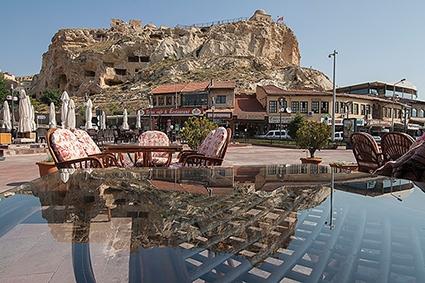To Nino’s House, Part 1
At last: Neither my wife, who is Georgian, nor I, had yet been able to visit Cappadocia in central Turkey- until now. An opportunity arose. We handed off the barn denizens to some very willing friends, packed the car and set off early in the morning.
First leg, drive to Batumi and park the car. I could have driven the whole distance, or flown to a local airport, but these seemed to be expensive options, with all flights having to go through either Istanbul or Ankara, far out of our way. So, bus it would be. Here, the options are many, what with various competing bus lines.
The border was ridiculously easy, after a five-minute online process had secured me a visa in advance, which my wife didn’t need anyway. A shared taxi to Hopa, first border town in Turkey; then it would have to be an overnight bus to the town nearest our hotel. There seemed to be no other choice to meet the deadline for registering with our hotel, so we resigned ourselves and boarded.
This night turned out not to be as hellish as I thought; we both managed to get a bit of sleep, on smooth roads with relatively quiet passengers. Still, sleeping in a bus seat is never easy for us, so it was fits and starts.
Turkey continues to seem very well developed after Georgia, one must say; there is serious money, along with a hard work ethic, on display here in infrastructure. Even though tourism from outside has suffered a great drop since recent events in the country’s main airport and in its politics, things are open as usual and Turks seem to be taking advantage of the downturn to holiday more internally. Plus, it was the end of Ramadan, so they were likely travelling more for this holiday.
Cappadocia is beloved by Georgians as the home of two of the country’s most important saints: George the dragon-slayer, patron of the country, and Nino, she who brought Christianity to flower as a slave woman in the royal household in Mtskheta. This region, of about 5,000 square kilometers and formerly part of the territory of ancient Greece, also contains some of the weirdest landscapes this photographer has ever seen, formed by erosion acting on volcanically deposited layers of stone of varying hardness. The resulting columns and large-scale rock textures must be seen to be believed. The region’s name is derived from a Persian description, Land of Beautiful Horses.
Our bus eventually deposited us in Nevsehir, as close as we could get to our hotel by this transport, at 6am. We left our luggage in a willing taxi office and walked around the town center for a while.
Now, Vardzia and Uplistsikhe are remarkable cave cities in Georgia, definitely worth seeing. But Cappadocia is full to bursting with such places, and are also mixed with living communities, some of which use and even make more caves to this day. Nevsehir is one of many such. The fantastic shapes that wind and water have made in the rock also contain vibrant towns and tourist sites. Vardzia juxtaposed with a children’s playground? I must say I’m glad that local people can earn a living both by being here and by making a visit to this place enjoyable for outsiders.
Next week, more details of this stunningly beautiful place and what we found here.
Tony Hanmer has lived in Georgia since 1999, in Svaneti since 2007, and been a weekly writer for GT since early 2011. He runs the “Svaneti Renaissance” Facebook group, now with nearly 1500 members, at www.facebook.com/groups/SvanetiRenaissance/
He and his wife also run their own guest house in Etseri:
www.facebook.com/hanmer.house.svaneti
Tony Hanmer












